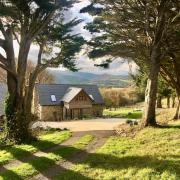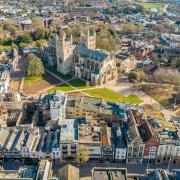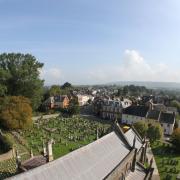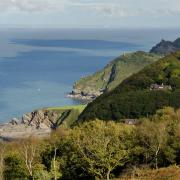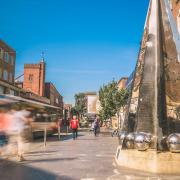The Jurassic Coast in East Devon has some great beaches where you might find an ancient fossil from our prehistoric past
Discovering a piece of Early Cretaceous history would certainly add to the magic of your next beach trip. The Jurassic Coast – which stretches 95 miles from Exmouth to Studland in Dorset – is rich in a huge variety of fossils, including ammonites and brachiopods. These tiny windows into life millions of years ago have been drawing explorers to these cliffs for generations.
But what is it about spotting a bivalve shell or tubeworm layer that people find so rewarding?
“It’s that sense of discovery,” says fossil finder Martin Curtis. “You’ve gone out hunting for something and when you find it and it’s a good example, you get a connection to that fossil. That feeling never goes away.”
Jurassic Coast guide Martin has been exploring the wonders of the cliffs and beaches along this World Heritage Site for years. He and other enthusiasts say anyone can have a go at fossil hunting, as long as you know where to look and what to look for. Some fossils are way beyond our reach (and far too dangerous to find) but others are easier to uncover.

Martin says it’s a case of clearing your mind and focussing on certain colours, textures and shapes.
“You don’t need to be a palaeontologist,” he says. “You can train your eyes to find fossils. It’s a natural process that we can all do.”
Martin says the best and easiest places to find fossils are Charmouth and Lyme Regis beaches in Dorset. But he and other local enthusiasts say there are also a number of key spots in East Devon.
Beer resident and fossil fan Mike Green has been running sessions for children at Devon Wildlife Trust’s Seaton Jurassic centre, teaching them some basic geology and what to look out for on the local beaches.
“East from Branscombe towards Beer Head is Hooken Beach, where you can find loads of bivalve shells from the Early Cretaceous in the huge boulders that have fallen from the cliffs above,” says Mike, a Jurassic Coast ambassador. “And you can look out for bits of tubeworm layer. At first glance it looks like a flat large pebble, covered in small ammonites, but they are not. This is a particular layer from the Early Cretaceous and they can be found on the beaches from Littlecombe Shoot, Branscombe (the local pronunciation is Liddie-cum-shute) all the way to Culverhole Point, east of the River Axe.”
Mike, who says fossil hunting is simply a much-loved hobby of his, agrees the thrill is in the discovery of something no human has ever laid eyes on.
“There’s just something about it,” he says. “When you find a fossil, you know that you’re the first person ever to see it.”
Both Martin and Mike make it clear that there is a strict fossil finding code. You can’t dig out of the cliffs or permanent bedrock and must take only small, loose fossils. A falling tide is best but keep an eye on it and stay safe. Once you’ve checked the rulebook, the thrill of the chase can begin.
“That buzz never goes away,” says Martin, who has loved fossils since he was three. “Anyone can go to a shop and buy one but it doesn’t mean anything; it doesn’t tell a story,” he adds, explaining that looking for these tiny pieces of our planet’s past can be part of a memorable family day out.
“You take a picnic, go down to the beach and find a fossil which then holds that memory every time you look at it. That’s pretty special.”
How well do you know the ancient sites of Devon?

Where to find fossils in East Devon
Mike Green has kindly put together these top tips for fossil hunters.
The Jurassic layer in East Devon starts after a 90-minute walk along the beach from Axmouth going east – a formation known locally as ‘the Slabs’. There are loads of ammonites especially at low tide.
The best place to see a load of ammonites is to travel to Lyme Regis (Dorset) and walk back along the beach (westward) towards Seaton from Monmouth Beach. After about a 40-minute walk into East Devon, you will come to the ammonite pavement. This is Early Jurassic and spectacular – easy to find and see.
It’s best if you go on a spring low tide i.e. on a full or new moon and for a couple of days after. The strongest tides in East Devon occur when low tide is around lunchtime 2pm-ish.
At Branscombe to the west of Branscombe Mouth, you can see layers of Gypsum in the cliffs that were formed by Playa lakes (temporary lakes in the Triassic desert). The water evaporates and leaves behind the salts. In the 1800s there was an industry in Branscombe based on Gypsum, which is also known as Plaster of Paris.
East from Branscombe towards Beer Head is Hooken Beach, where you will find loads of bivalve shells.
Budleigh to Seaton: The red cliffs of East Devon are Triassic and were formed in a desert – so not many fossils and almost impossible to find unless you know what you are looking for. Fossils in the Triassic are rare.
Seaton Hole – On the beach between Seaton Hole and Beer you can find bivalves and ammonites in the rocks that have fallen from the cliffs above.
Search the pebble beaches along the East Devon Coast for fossil sea urchins in flint pebbles and the occasional bivalve (2 shells). You can also look for a “Budleigh Bun” – a pebble from Budleigh beach, washed eastward up the channel by a process called longshore drift. They tend to be round, flat and purple-coloured. They make great skimmers for playing Ducks & Drakes.
You might also find: whelk eggs – Duncow (Dogfish/Rock Salmon) eggs; cuttlefish bones (did you have a budgie when you were young?); bits of plastic from the Napoli (the ship, wrecked off the East Devon coast in 2007) still turn up.




